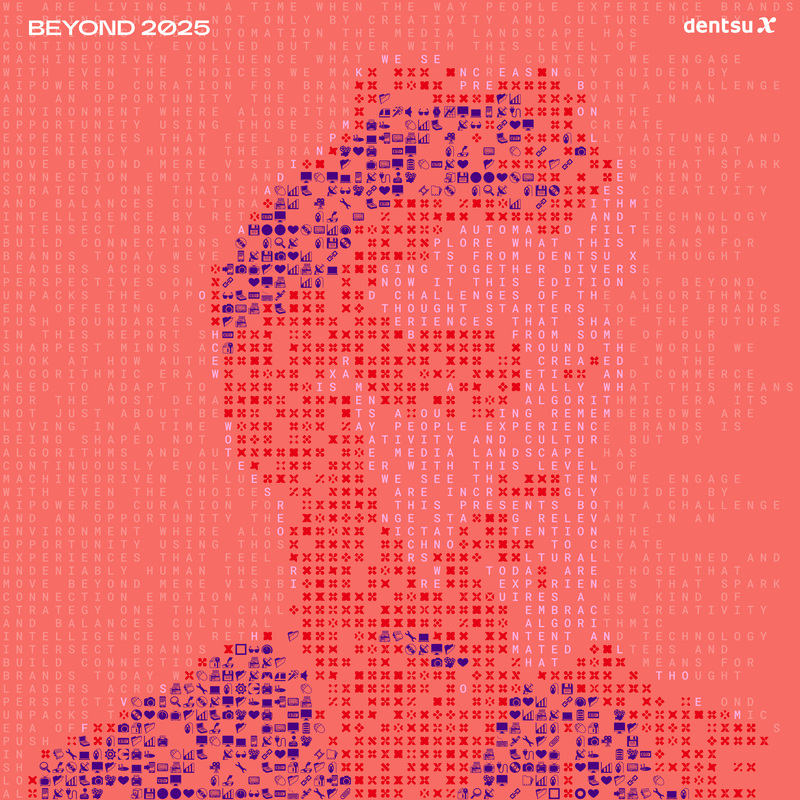This blog is inspired by dentsu’s Beyond 2025: Winning in the Algorithmic Era, a global thought leadership series exploring how brands can navigate a future shaped by AI, automation, and always-on algorithms.

When Did We Start Marketing to Machines?
Picture this: You’re scrolling through your feed, dodging an onslaught of targeted ads. You pause on a pair of trainers for just a moment, and suddenly, they haunt your every digital move, appearing in your inbox, your news articles, your smart fridge, possibly even your dreams. Welcome to the Algorithmic Era, where AI decides what we see, when we see it, and how often we’ll be reminded that we never actually clicked buy.
For brands, this era presents a paradox. On one hand, AI is a marketer’s best friend—predicting behavior, personalizing content, and optimizing at scale. On the other hand, it’s creating a world where consumer choices are no longer truly choices. The algorithm pre-selects our music, our films, our shopping habits, even our romantic matches. So, if everything is curated by AI, what does that mean for brands trying to create meaningful experiences? Are we still marketing to humans, or are we just playing to the whims of machine learning models?
It’s time for brands to take back control, not by rejecting AI, but by designing experiences that cut through the noise – experiences that are unpredictable, unfiltered, unmistakably human.
Designing for Humans in an AI World
Let’s be honest. AI has made marketing more efficient, but not necessarily better. We’ve optimized the life out of content. Engagement has become a numbers game. Click-through rates, dwell time, and impressions have taken center stage, while genuine emotional connection has taken a backseat. The result? A digital landscape full of polished but forgettable brand interactions—content that feels like it was written by an AI trying very hard to sound like a person (ironically, something we’re actively trying to avoid here).
So, what’s the antidote to algorithmic sameness?
Creativity. Chaos. The unexpected.
In other words, the very things that make human experiences so compelling in the first place. Brands need to shift their focus back to human engagement, designing for emotional impact rather than algorithmic approval, and start designing content and media strategies that resonate beyond the feed. This means creating moments that are too good to not share, crafting stories that move people (not just move them down a funnel), and leveraging cultural moments that machines can’t anticipate.
When the Algorithm Fails: The Power of Unscripted Moments
Want to know what algorithms are terrible at? Surprise. Spontaneity. Moments of pure, unfiltered, unpredictable human joy.
Think about the most talked-about brand experiences in recent years. Did they go viral because they were perfectly optimized for an algorithm? No. They worked because they tapped into something bigger—an emotion, a cultural movement, a shared experience that couldn’t be ignored.
Take Ocean Spray’s TikTok moment with Nathan Apodaca skateboarding to Fleetwood Mac’s Dreams. Zero paid media. No targeting strategy. Just a guy on a longboard, drinking cranberry juice, and vibing to a song from 1977. It resonated because it was authentic, and the internet felt it. Ocean Spray leaned in, embraced the moment, and watched sales soar. No AI could have predicted that.
Now, contrast that with the thousands of hyper-targeted, AI-optimized ad campaigns that go unnoticed every day. Which approach would you rather take?
Beyond Visibility: Designing for Experience
The challenge today isn’t just about getting seen—it’s about creating experiences that are felt. Algorithms can push content, but they can’t create cultural moments. They can optimize reach, but they can’t manufacture relevance. That’s where brands must step in.
So how do we design experiences that defy the expected? Here are three principles to guide the way.
1. Culture Over Clicks
AI is great at identifying what’s trending, but it’s terrible at creating culture. The best brand experiences come from a deep understanding of what people, not just data points, feel. This means moving beyond trend-jacking and actually investing in culture, subcultures, and the communities that shape them.
Example: Instead of simply chasing viral dances on TikTok, brands like Nike invest in grassroots sports movements, ensuring their relevance extends beyond a trending hashtag.
2. The Art of the Unpolished
Highly curated, overproduced content screams advertisement, and audiences have become experts at tuning it out. The best-performing content often feels raw, organic, and unfiltered—because it is.
Example: Look at how Duolingo's chaotic and weirdly relatable TikTok strategy has made it one of the most engaging brands on the platform. The content is playful, self-aware, and—most importantly—feels human.
3. The Unexpected Wins
Predictability is the death of engagement. AI-driven optimization often leads to a sea of sameness, where brands all start looking, sounding, and feeling identical. Instead, brands should focus on disrupting the expected.
Example: When Burger King hid a Big Mac behind every Whopper in its ads, it wasn’t just a cheeky swipe at McDonald's—it was a moment of creative brilliance that made people pay attention.
The Future: Balancing Algorithms and Authenticity
AI is here to stay, and it’s only getting smarter. But if brands want to create experiences that last, they can’t afford to let algorithms dictate their every move. The future belongs to brands that can strike a balance—leveraging AI’s efficiencies while maintaining the creative, cultural, and human instincts that no machine can replicate.
Success in the Algorithmic Era won’t come from playing by AI’s rules. It will come from breaking them. From designing for humans first, algorithms second. From creating experiences that resonate.
At the end of the day, no one remembers the best-optimized ad they saw. But they do remember the experience that made them feel something. And that’s the real power of marketing in the age of AI.
To explore more trends and brand implications, download Beyond 2025: Winning in the Algorithmic Era.

